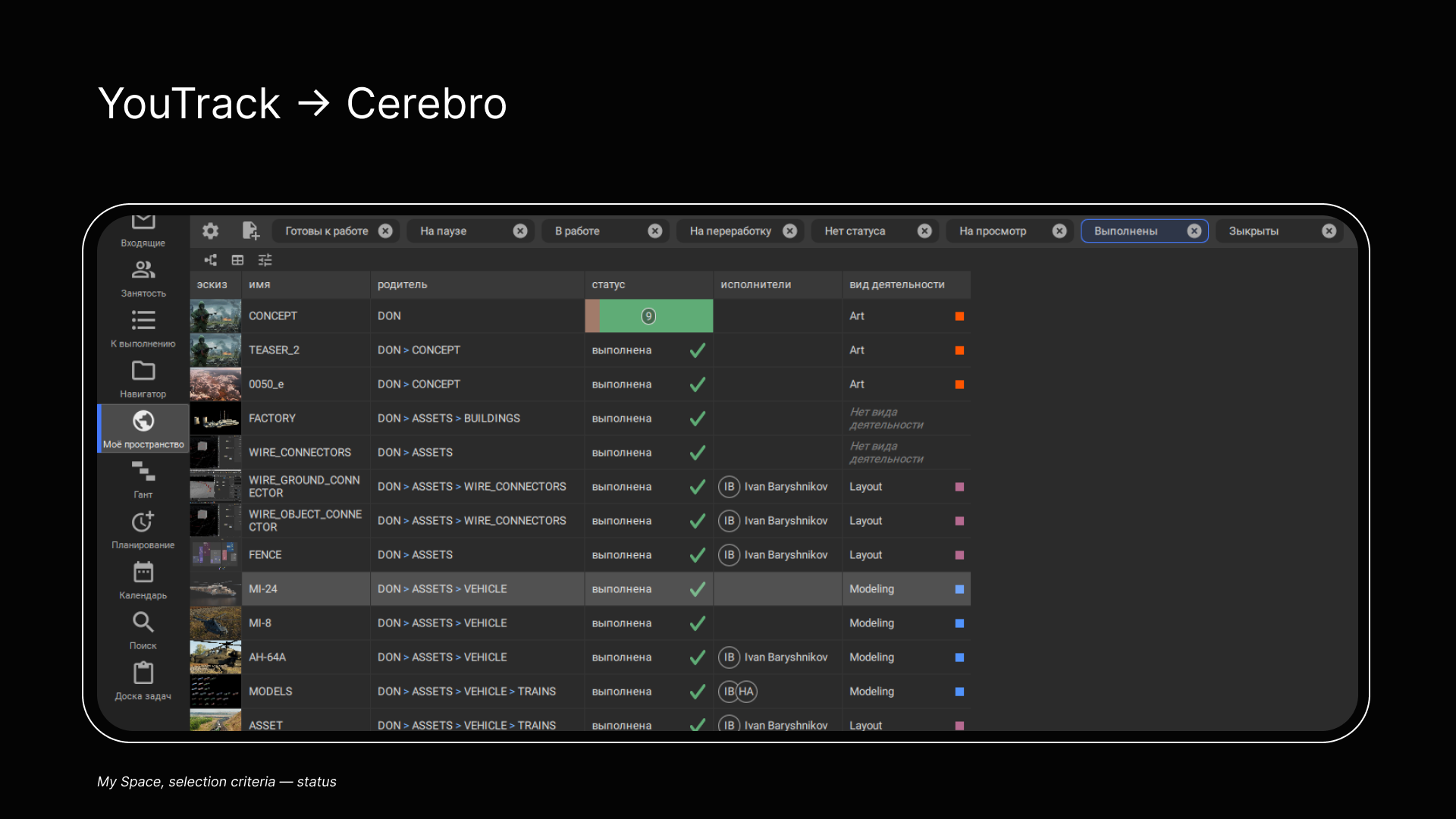At Cerebro, we develop a project management system tailored for companies involved in CG, VFX, and animation. Our tools help studios automate workflows and manage creative projects.
In this article, we look at how companies, educational institutions, and creative associations utilize our program to build pipelines. The content is derived from a presentation delivered by our manager, Alyona Dianova, at the CG RAVE 2024 event.
1-2-3 VFX: Setting up a system for a project of considerable scale
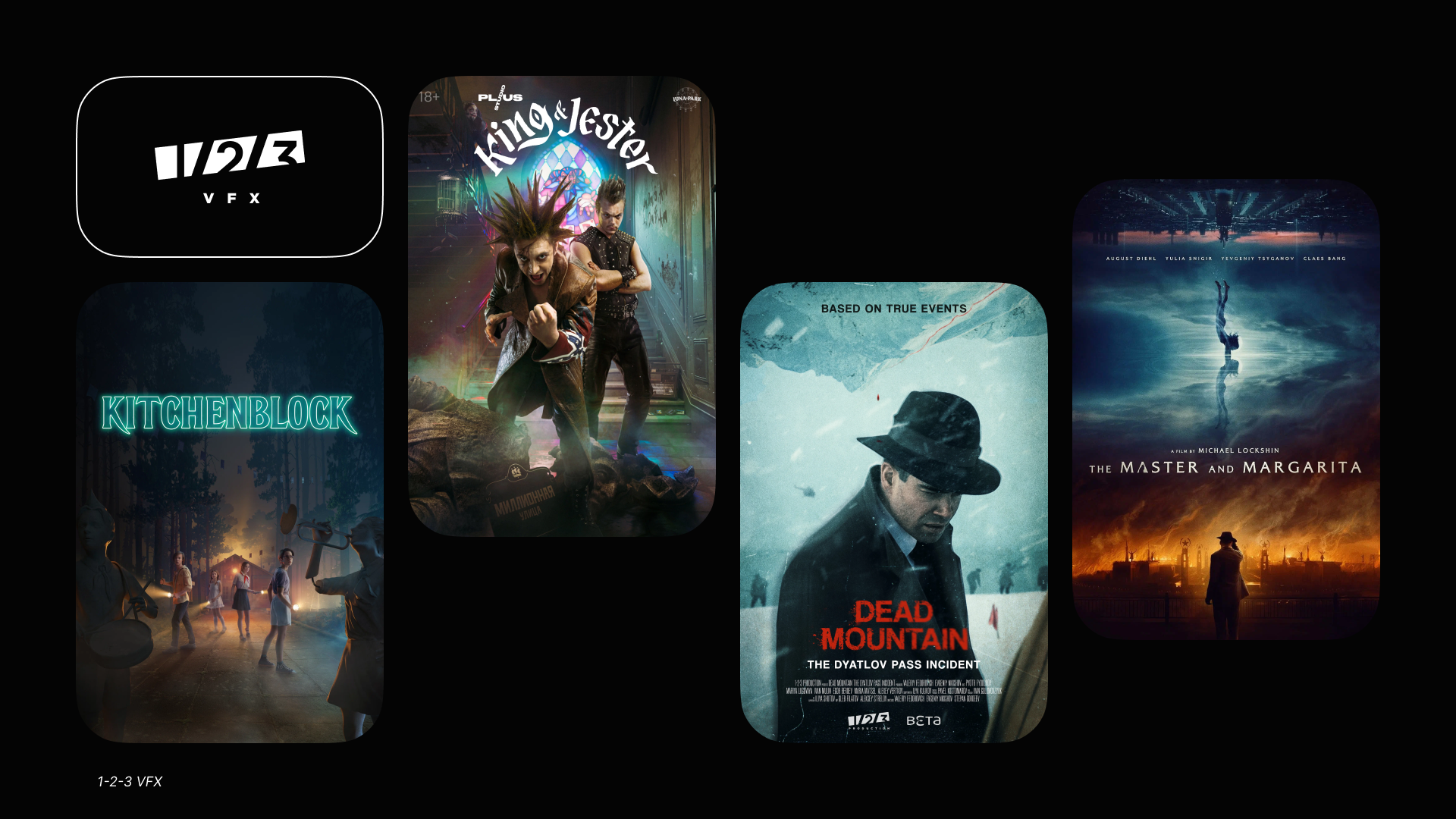
1-2-3 VFX specializes in computer graphics. Among its recent projects is The Master and Margarita film, which the team used as an example to discuss their organizational processes in greater detail:
“About 60 people helped make the film, including producers, supervisors, in-house and freelance staff, and technical support personnel. Our studio follows a typical role distribution model with distinct departments, each overseen by its own supervisor. The project supervisor ensures the cohesive visual direction of the project and maintains direct communication with the director, receiving feedback firsthand. Additionally, there is a chief producer and coordinators who aid them in managing the multitude of tasks.

Due to the project’s significant scale, it necessitated a sophisticated organizational setup and a vast server framework for storing and transmitting materials, all of which required meticulous management. Within Cerebro, we worked in two universes, executing tasks and providing feedback on other vendors’ work. A collaborative universe for vendors made tracking shot progress easier and facilitated the exchange of materials and feedback where joint work was involved. Furthermore, our project supervisor used this shared space to review the output of other studios.
Additionally, we worked on the project in our own studio universe, leveraging existing mechanics to build a tailored project system for our tasks. This setup allowed us to extensively manipulate materials on our server and refine shots until they were ready for collective presentation to the director and producers.
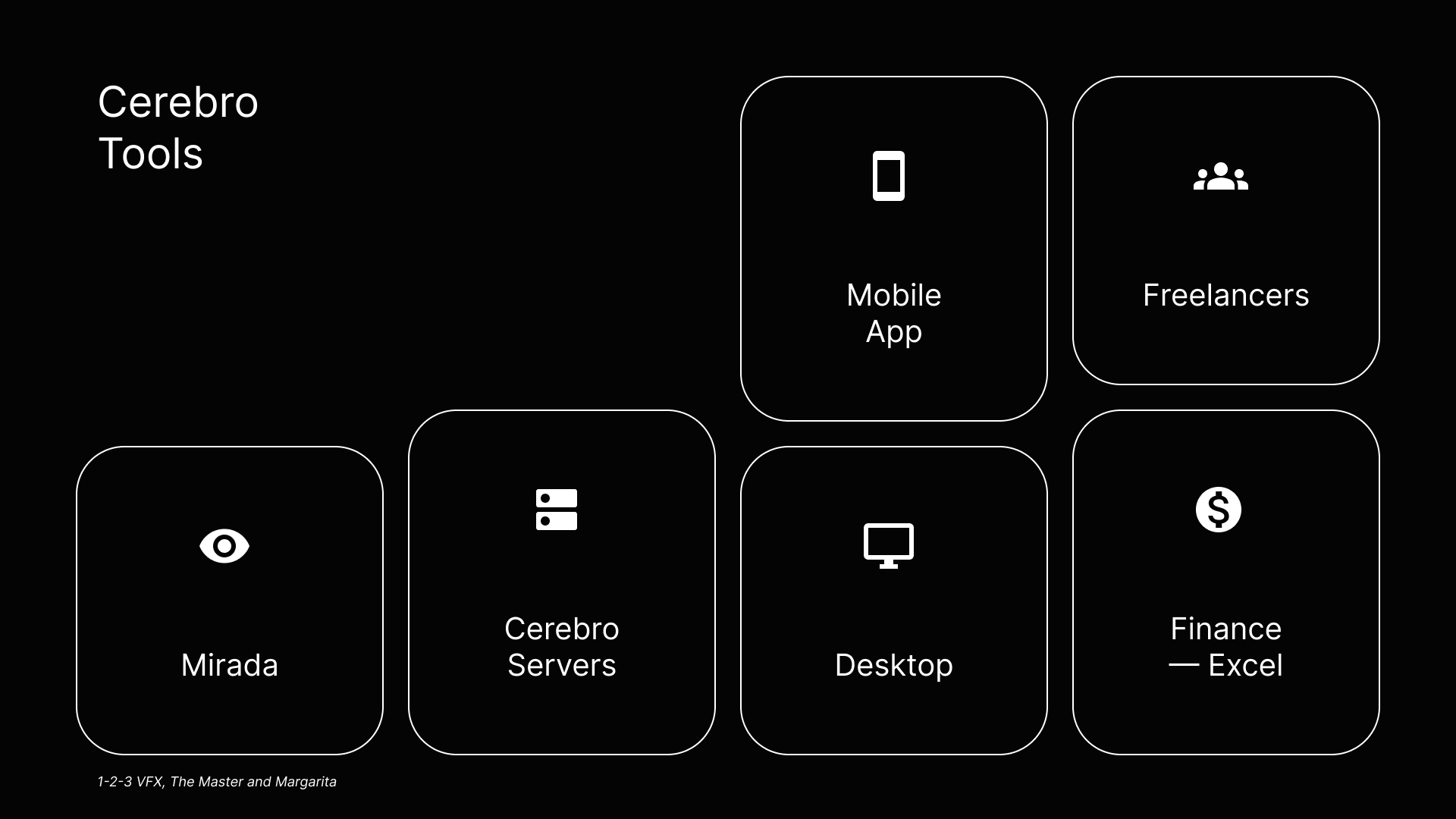
We rely heavily on Mirada for viewing, commenting, and comparing versions across all our projects. When collaborating with freelancers, we opt to link them through Cerebro for discussions. The customizable pages feature is particularly handy for management purposes, especially when sorting numerous tasks based on specific criteria. For instance, we frequently use this feature to identify unassigned active tasks or when the supervisor sets a “send material” status. Such functionality becomes indispensable in managing large projects, ensuring we stay organized and don’t miss anything.
We utilize tasks to monitor work hours, with vendors and supervisors logging their time spent on specific activities. This enables us to analyze and compare our initial estimates with the actual hours invested. Moreover, tracking hours allows us to take prompt action if we notice any tasks exceeding their deadlines. In such cases, we aim to promptly address the issue by discussing it with the vendor and identifying suitable solutions, such as seeking assistance from another department or exploring alternative technologies for the task.
Effective teamwork and meticulous management are essential for the success of large projects. To put it simply, it’s like managing a vast and intricate production line, but in a positive sense. Planning the graphics creation process during post-production requires careful consideration in advance. There’s a considerable amount of material that needs to be appropriately distributed among vendors, who must then be introduced to each other and agree on general “rules of the game,” spanning from technical project specifications to handling dailies and statuses. And then, after navigating through all the intermediate stages, the material must be properly submitted for the final assembly. The system you devise must be functional and adaptable to accommodate any changes that may arise throughout the course of long-term projects. In this regard, we take pride in our collaborative organizational efforts, which have allowed us to achieve such remarkable results on the big movie theater screens.”
Film Direction: Switching from ShotGrid to Cerebro
Film Direction is one of the leading Russian creators of visual effects for films and TV series. The studio employs over 50 people, with its portfolio boasting projects for more than 40 major films. In 2020, the company won the Golden Eagle Award for best visual effects in the film Union of Salvation.
In 2023, the team decided to switch from ShotGrid (now Flow Production Tracking) to Cerebro.

Speaking of the benefits of this transition, the cloud storage and flexibility offered by Cerebro immediately stand out. Each studio has its own unique pipeline for working on projects, so it’s crucial to customize the software according to specific tasks and programs. Additionally, we’ve developed our own plugins to enhance the functionality of professional tools. The switch in software has enabled us to effectively oversee all production stages across various projects. Typically, artists use only a small fraction of Cerebro features. The features and interface for supervisors and coordinators are also pretty straightforward.
Here’s how it works: a coordinator uses Cerebro to provide artists with all necessary materials for their shot assignments. Artists regularly submit daily progress reports, allowing us to effectively monitor production stages and identify any issues that arise. The status system allows coordinators to track real-time progress, indicating when a shot is in production or has been submitted for supervisor review.
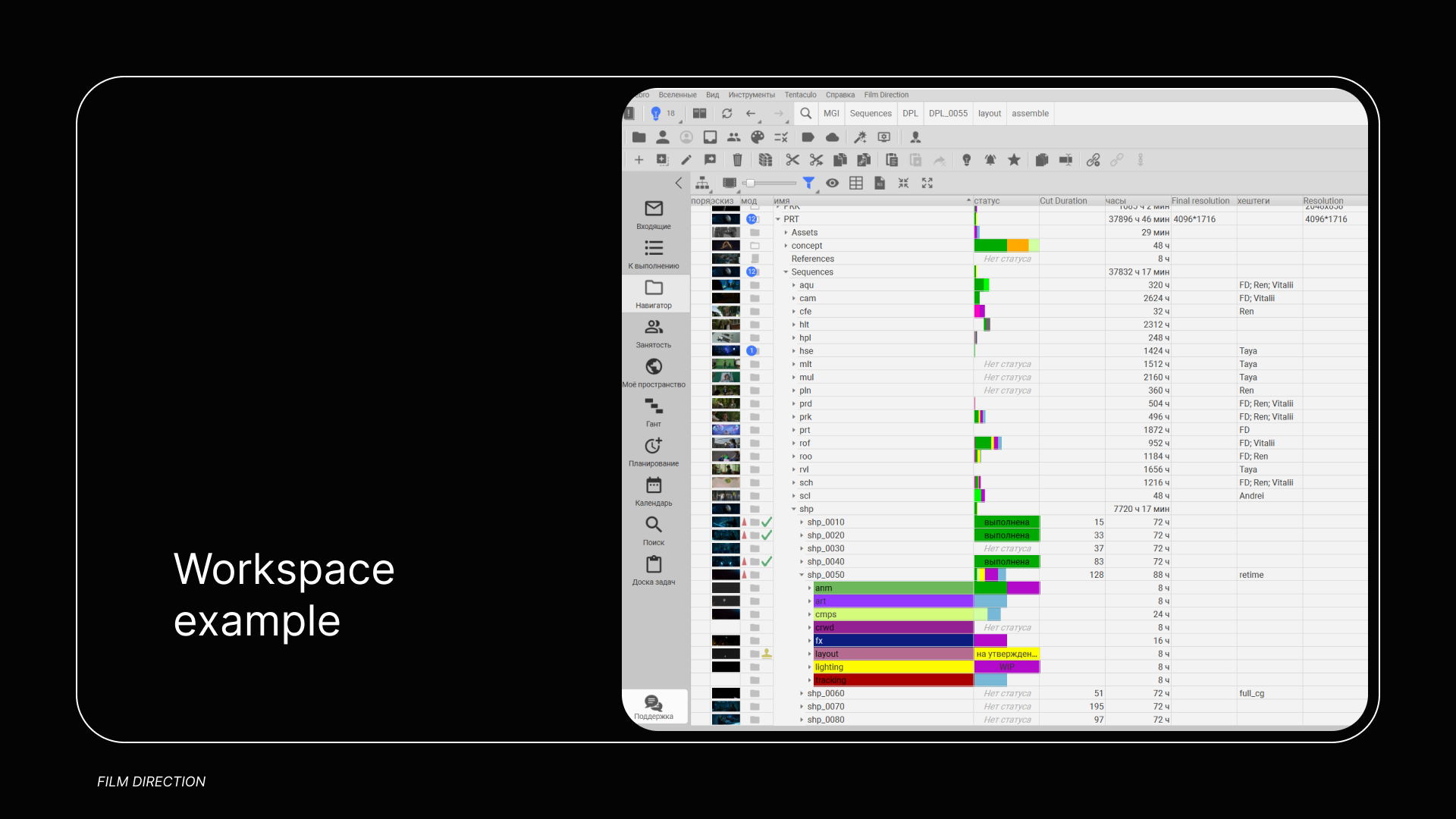
To streamline our workflow, the studio has developed a plugin enabling seamless transfer of task-related information (such as shot names, tasks, and task durations) directly from our breakdown to Cerebro. This significantly reduces the need for manual data entry. Moreover, Cerebro’s adaptability enables it to integrate with virtually any program and customize a range of tools to suit our needs.
Klaxon Production: Facilitating remote collaboration with studios and vendors
Established in 2022, Klaxon Production is a young production company specializing in the creation and promotion of animated projects for children. Its primary YouTube channel boasts over 80 million views, and its animated series are broadcast on the Karusel and O! TV channels, as well as on Kinopoisk. Their latest project, Hunch and Crunch, explores the topic of responsible consumption, guided by the motto “Moderation!” Let’s take a closer look at the studio’s production processes.
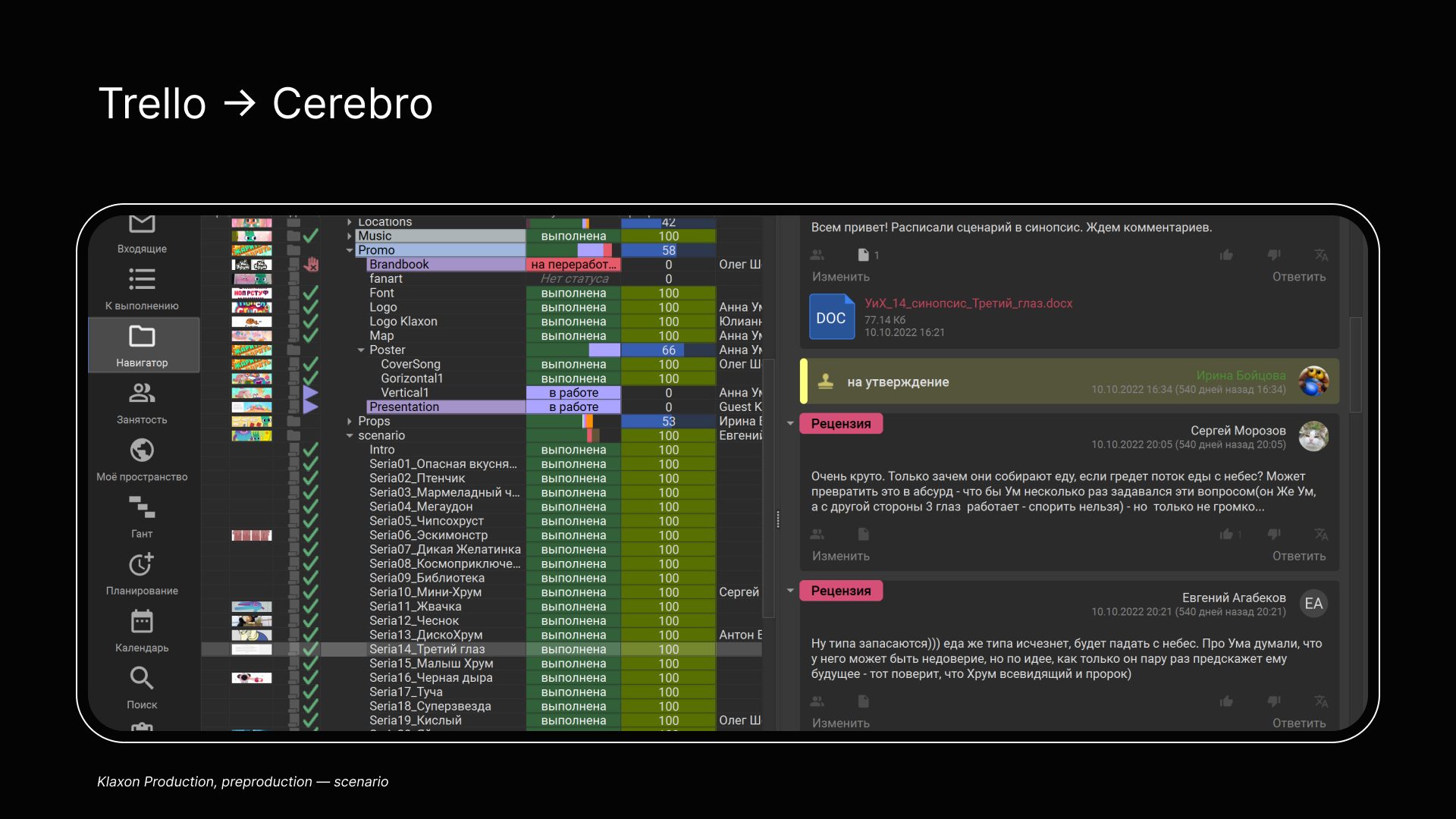
At first, our team managed tasks using simple tools like email, Skype, and spreadsheets, suitable for handling basic assignments. However, as projects grew more complex, we realized that we needed a system capable of handling the growing volume of tasks and adapting to evolving work dynamics. We now had to go beyond our studio spaces, collaborate with remote vendors, and organize joint work with other studios. The first system we decided to try was Trello, but given that some of our artists possessed 15 years of experience with Cerebro, we opted to explore this familiar platform. This decision was reinforced when we collaborated with Aeroplan on the Flora’s Team project, where they also utilized Cerebro. Subsequently, we adopted Cerebro to manage the Hunch and Crunch project.
Today, Cerebro serves as our team’s primary tool for project management and task completion. It allows users to download materials and start working on them at any time and from any location. Team leads monitor project statuses while also managing costs and minimizing downtime. When assigning tasks, we take advantage of the flexible task settings, like relocating employees from one task to another.

One of the adjustments made by the team to tailor the system to our needs is customized task statuses, which you can see on the slide above. Some of our favorite features and tools include group status updates, Mirada, PDF comment export, task progress bar, task assignments, Tentaculo, and direct file download links.
Klaxon Production experts view Cerebro as an ideal solution for facilitating distributed and remote work without relying on large studio spaces. It enables employees to work from any location while still keeping in touch and fosters communication and creative collaborations.
Ivan Baryshnikov and the Volga team: Managing a creative project
Ivan Baryshnikov is an FX artist and director of his own short war film project Don, which is set in the alternate 1980s. With prior experience at Trehmer, CGF, and Premier Studios, he currently holds a position at Gaijin.
At first, Ivan worked on the Don project solo. However, more recently, he has formed the Volga team, comprising like-minded individuals from various domains of the movie industry. Together, they are collaborating on the short film while following all the principles of traditional cinematic storytelling.
“While working on various projects, I came across different types of task managers. When it came time to select software for my own creative project, some options, like YouTrack with its board system, seemed cumbersome, and there wasn’t sufficient time for extensive customization.
As a result, I opted to work on Don using Cerebro, a platform I was already familiar with from my previous places of employment. Although it may initially appear not very intuitive, it’s actually quite user-friendly for both supervisors and vendors, as I’ve learned through experience.
In my case, I customized My Space to align with the project’s tasks, ensuring that every artist, especially newcomers, could readily grasp the project’s progress.”
HSE Art and Design School: Utilizing a pipeline in the educational process
In 2023, the system was used by 121 students as well as teachers – experienced industry professionals. The students show a preference for the mobile and web versions, while their teachers tend to favor the desktop version.
We previously published a video interview with Aleksey Kukharonok, the head of the CGI and Visual Effects department at the HSE Art and Design School:
During the CG RAVE event, which the School helped organize, Aleksey discussed the latest developments in his field:
“When you have 70 students taking one course and 70 students taking another one, organizing the educational process becomes essential. Cerebro seemed like a fitting solution.
As the process manager, this allows me to “kill two birds with one stone.” Firstly, it allows teachers and myself to ensure that homework assignments are formulated correctly and that students have acknowledged, submitted, and completed the tasks. Secondly, it familiarizes students with the software they will encounter in their first professional studio after graduation.”
The students may not be overly enthusiastic about it, but they still make use of the tools we incorporate into the process.
All of our students have Cerebro accounts through which they receive assignments. Currently, our second, third, and fourth-year students are actively utilizing the system, with the fourth-year students particularly involved in extensive graduation projects. Within the tasks, students can view the materials they’ve uploaded, any comments provided by the teacher, as well as the status of the task, indicating whether it’s active or not.
In my opinion, this is very convenient. As project managers, teachers engage in extensive communication, and I have the ability to access any thread to assess task progress. Additionally, I can navigate to the forum, review comments, and reconstruct the project timeline. This approach allows us to emulate the studio work environment, enriching the learning experience.”

